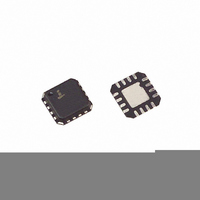ISL6292-2CR5Z Intersil, ISL6292-2CR5Z Datasheet - Page 15

ISL6292-2CR5Z
Manufacturer Part Number
ISL6292-2CR5Z
Description
IC CHARGER LI-ION POLYMER 16-QFN
Manufacturer
Intersil
Datasheet
1.ISL6292-2CR5Z-T.pdf
(20 pages)
Specifications of ISL6292-2CR5Z
Function
Charge Management
Battery Type
Lithium-Ion (Li-Ion), Lithium-Polymer (Li-Pol)
Voltage - Supply
4.3 V ~ 6.5 V
Operating Temperature
-20°C ~ 70°C
Mounting Type
Surface Mount
Package / Case
16-VQFN Exposed Pad, 16-HVQFN, 16-SQFN, 16-DHVQFN
Lead Free Status / RoHS Status
Lead free / RoHS Compliant
Available stocks
Company
Part Number
Manufacturer
Quantity
Price
Company:
Part Number:
ISL6292-2CR5Z
Manufacturer:
Intersil
Quantity:
135
Input and Output Capacitor Selection
Typically any type of capacitors can be used for the input
and the output. Use of a 0.47µF or higher value ceramic
capacitor for the input is recommended. When the battery is
attached to the charger, the output capacitor can be any
ceramic type with the value higher than 0.1µF. However, if
there is a chance the charger will be used as an LDO linear
regulator, a 10µF tantalum capacitor is recommended.
Current-Limited Adapter
Figure 24 shows the ideal current-voltage characteristics of
a current-limited adapter. V
voltage and V
I
adapter presents the characteristics of a voltage source. The
slope r
supply. For a well regulated supply, the output resistance
can be very small, but some adapters naturally have a
certain amount of output resistance.
The adapter is equivalent to a current source when running
in the constant-current region. Being a current source, its
output voltage is dependent on the load, which, in this case,
is the charger and the battery. As the battery is being
charged, the adapter output rises from a lower voltage in the
current-voltage characteristics curve, such as point A, to
higher voltage until reaching the breaking point B, as shown
in Figure 24.
The adapter is equivalent to a voltage source with output
resistance when running in the constant-voltage region;
because of this characteristic. As the charge current drops,
the adapter output moves from point B to point C, shown in
Figure 24.
The battery pack can be approximated as an ideal cell with a
lumped-sum resistance in series, also shown in Figure 24.
The ISL6292 charger sits between the adapter and the
battery.
High
Low
*Both outputs are pulled up with external resistors.
LIM
FAULT STATUS
FIGURE 24. THE IDEAL I-V CHARACTERISTICS OF A
V
V
. Before its output current reaches the limit I
NL
FL
O
Low
High
represents the output resistance of the voltage
V
C
r
CURRENT LIMITED ADAPTER
FL
NL
O
TABLE 2. STATUS INDICATIONS
is the full load voltage at the current limit
Charging in one of the three modes
Fault
r
O
NL
= (V
I
LIM
15
is the no-load adapter output
NL
- V
INDICATION
FL
)/I
I
LIM
LIM
B
A
V
CELL
LIM
, the
R
V
PACK
PACK
ISL6292
Working with Current-Limited Adapter
As described earlier, the ISL6292 minimizes the thermal
dissipation when running off a current-limited AC adapter, as
shown in Figure 18. The thermal dissipation can be further
reduced when the adapter is properly designed. The
following demonstrates that the thermal dissipation can be
minimized if the adapter output reaches the full-load output
voltage (point B in Figure 24) before the battery pack voltage
reaches the final charge voltage (4.1V or 4.2V). The
assumptions for the following discussion are: the adapter
current limit = 750mA, the battery pack equivalent
resistance = 200mΩ, and the charger ON-resistance is
350mΩ.
When charging in the constant-current region, the pass
element in the charger is fully turned on. The charger is
equivalent to the ON-resistance of the internal P-Channel
MOSFET. The entire charging system is equivalent to the
circuit shown in Figure 25A. The charge current is the
constant current limit I
can be easily found out as calculated in Equation 13:
where V
dissipation in the charger is given in Equation 2, where
I
A critical condition of the adapter design is that the adapter
output reaches point B in Figure 24 at the same time as the
battery pack voltage reaches the final charge voltage (4.1V
or 4.2V), that is:
For example, if the final charge voltage is 4.2V, the r
is 350mΩ, and the current limit I
adapter full-load voltage is 4.4625V.
When the above condition is true, the charger enters the
constant-voltage mode simultaneously as the adapter exits
the current-limit mode. The equivalent charging system is
shown in Figure 25C. Since the charge current drops at a
higher rate in the constant-voltage mode than the increase
rate of the adapter voltage, the power dissipation decreases
as the charge current decreases. Therefore, the worst case
thermal dissipation occurs in the constant-current charge
mode. Figure 25A shows the I-V curves of the adapter
output, the battery pack voltage and the cell voltage during
the charge. The 5.9V no-load voltage is just an example
value higher than the full-load voltage. The cell voltage
4.05V uses the assumption that the pack resistance is
200mΩ. Figure 26A illustrates the adapter voltage, battery
pack voltage, the charge current and the power dissipation in
the charger respectively in the time domain.
V
CHARGE
V
Adapter
Critical
PACK
=
=
= I
I
I
LIM
LIM
LIM
is the battery pack voltage. The power
⋅
⋅
.
r
r
DS ON
DS ON
(
(
LIM
)
)
+
+
, and the adapter output voltage
V
V
CH
PACK
LIM
is 750mA, the critical
December 17, 2007
DS(ON)
(EQ. 14)
(EQ. 13)
FN9105.9













